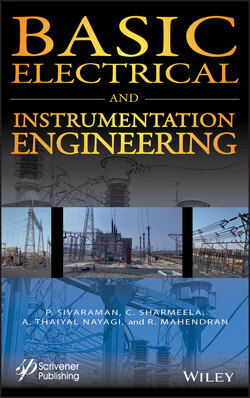Basic Electrical and Instrumentation Engineering

Реклама. ООО «ЛитРес», ИНН: 7719571260.
Оглавление
P. Sivaraman. Basic Electrical and Instrumentation Engineering
Table of Contents
List of Illustrations
List of Tables
Guide
Pages
Basic Electrical and Instrumentation Engineering
Dedications
Foreword
Acknowledgements
1. Introduction to Electric Power Systems
1.1 Introduction
1.1.1 Electrical Parameters
1.1.1.1 Voltage
1.1.1.2 Current
1.1.1.3 Time Period and Frequency
1.1.1.4 Phase Angle (ɸ)
1.2 Three-Phase Supply Connections
1.2.1 Star Connection
1.2.2 Delta Connection
1.2.3 Balanced Load
1.2.4 Unbalanced Load
1.2.5 Star – Delta Conversion
1.2.6 Delta to Star Conversion
1.3 Power
1.3.1 Real Power or Active Power (P)
1.3.2 Reactive Power (Q)
1.3.3 Apparent Power (S)
1.4 Power Factor (PF)
1.4.1 Classification Based on Load Characteristics
1.4.2 Classification Based on Harmonics Producing Loads
1.4.3 The Need for Power Factor Improvement
1.4.4 Methods of Power Factor Improvement
1.5 Types of Loads
1.5.1 Linear Loads
1.5.2 Non-Linear Loads
1.6 Three-Phase Power Measurement
1.7 Overview of Power Systems
1.7.1 Components of an Electric Power System
1.8 Protection of Power System
References
2. Transformers. 2.1 Introduction
2.2 Transformer Magnetics
2.3 Construction of Transformer
2.4 EMF Equation of a Transformer
2.5 Ideal Transformer
2.6 Transformation Ratio (K)
2.7 Circuit Model or Equivalent Circuit of Transformer
2.8 Voltage Regulation of Transformer
2.9 Name Plate Rating
2.10 Efficiency of Transformer
2.11 Three-Phase Transformer
2.12 Components of the Transformer
2.13 Standards for Transformers
References
3. DC Machines. 3.1 Introduction
3.1.1 DC Generators
3.1.2 DC Motors
3.1.3 Construction of DC Machines
3.2 Operation of DC Machines. 3.2.1 Principle of DC Generators
3.2.2 Operating Principle of Motors
3.3 EMF Equation of DC Generator
3.4 Torque Equation of a DC Motor
3.5 Circuit Model
3.5.1 Generator Mode
3.5.2 Motor Mode
3.5.3 Symbolic Representation of DC Generator
3.6 Methods of Excitation
3.7 Characteristics of DC Generator
3.7.1 Characteristics of Separately Excited DC Generator
3.7.2 Load Characteristics of DC Shunt Generator
3.7.3 Load Characteristics of DC Series Generator
3.7.4 Load Characteristics of DC Compound Generator
3.8 Types of DC Motor
3.9 DC Motor Characteristics
3.10 Necessity for Starters
3.11 Speed Control of DC Motors
3.12 Universal Motor
References
4. AC Machines. 4.1 Introduction
4.2 Three-Phase Induction Motor
4.2.1 Rotating Magnetic Field
4.2.2 Construction
4.2.3 Working Principle
4.2.4 Slip of an Induction Motor
4.2.5 Torque Equation
4.2.6 Torque–Slip Characteristics
4.2.7 Induction Motor as a Transformer
4.2.8 Equivalent Circuit of Induction Motor
4.3 Single-Phase Induction Motor. 4.3.1 Introduction
4.3.2 Working Principle
4.3.3 Types of Single-Phase Induction Motor
4.4 Starting Methods of Induction Motor. 4.4.1 Need for Starters
4.4.2 Types of Starters
4.5 Speed Control of Three-Phase Induction Motor
4.6 Synchronous Motor
4.6.1 Construction
4.6.2 Features of a Synchronous Motor
4.6.3 Working Principle
4.6.4 Starting Methods of Synchronous Motor
4.6.5 Torque Equation of Synchronous Motor
4.7 Stepper Motor
4.8 Brushless DC (BLDC) Motor
4.8.1 Construction
4.8.2 Working Principle
4.9 Alternator
4.9.1 Construction
4.9.2 Working Principle
4.9.3 EMF Equation of an Alternator
4.9.4 Voltage Regulation of an Alternator
4.10 Standards for Electric Machines
References
5. Measurement and Instrumentation
5.1 Electrical and Electronic Instruments
5.1.1 Classification of Instruments
5.1.2 Basic Requirements for Measurement
5.1.3 Types of Indicating Instruments
5.1.4 AC Indicating Instruments
5.1.5 Electrical Instruments
5.2 Cathode Ray Oscilloscope (CRO)
5.3 Digital Storage Oscilloscope
5.4 Static and Dynamic Characteristics of Measurements. 5.4.1 Static Characteristics
5.4.2 Dynamic Characteristics
5.5 Measurement of Errors
5.5.1 Types of Errors
5.6 Transducer
5.6.1 Classification of Transducers
References
Index
WILEY END USER LICENSE AGREEMENT
Отрывок из книги
Scrivener Publishing 100 Cummings Center, Suite 541J Beverly, MA 01915-6106
.....
A. Thaiyal Nayagi
R. Mahendran
.....